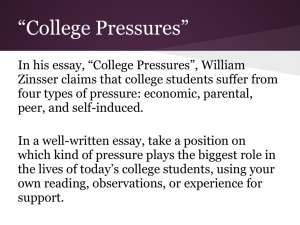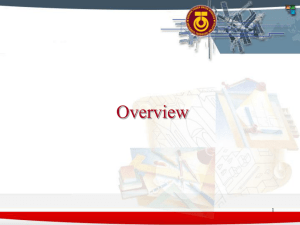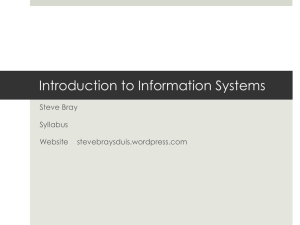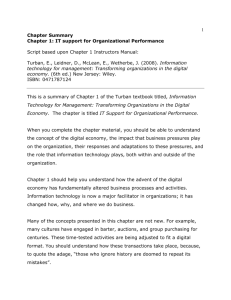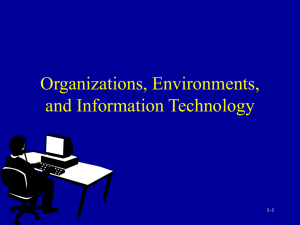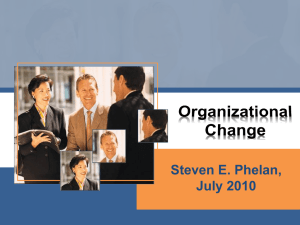Organization Design
advertisement
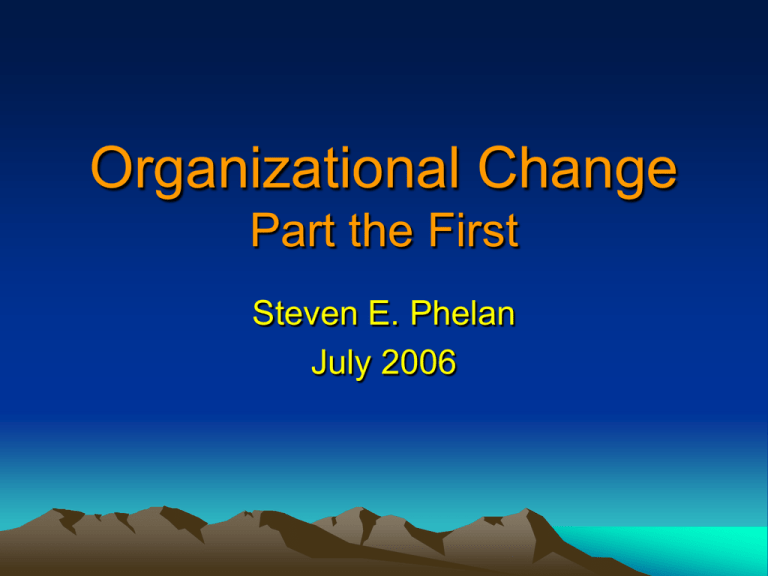
Organizational Change Part the First Steven E. Phelan July 2006 Images of Managing • Controlling… Top-down view of management Fayol’s theory of management: planning, organizing, commanding, coordinating and controlling. • Shaping… Participative style of management Improving the capabilities of people within the organization Images of Change Outcomes • Intended Change: Change is a result of planned action • Partially Intended Change: Change may need to be re-modified after it is initially implemented • Unintended Change: Forces beyond the control of the change manager Images of Change Managers Images of Managing Controlling . . . Shaping . . . (activities) (capabilities) Images of Change Outcomes Intended DIRECTOR COACH Partially Intended NAVIGATOR INTERPRETER Unintended CARETAKER NURTURER Images of Change Managers Director • Based on an image of management as control and of change outcomes as being achievable. • Supported by the n-step models and contingency theory. Coach • Relies upon building in the right set of values, skills and “drills” that are deemed to be the best ones that organizational members will be able to draw on in order to achieve desired organizational outcomes. • Related to organizational development approaches. Images of Change Managers Navigator • Control is still seen as at the heart of management action, although a variety of factors external to managers mean that while they may achieve some intended change outcomes, others will occur over which they have little control. • Supported by the contextualist and processual theories of change. Interpreter • The manager creates meaning for other organizational members, helping them to make sense of various organizational events and actions. • Supported by the sensemaking theory of organizational change Images of Change Managers Caretaker • The change manager’s ability to control is severely impeded by a variety of internal and external forces beyond the scope of the manager. The caretaker is seen as shepherding their organizations along as best they can. • Supported by life-cycle, population-ecology and institutional theories. Nurturer • Even small changes may have a large impact on organizations and managers are not able to control the outcome of these changes. However, they may nurture their organizations, facilitating organizational qualities that enable positive selforganizing to occur. • Related to chaos and Confucian/Taoist theories. Questions • To what extent are you more comfortable with one or other of the six images? Why is this the case? • What are the strengths and limitations of the images that you have identified as most relevant to you? • What skills do you think are associated with each image? Are there areas of personal skill development that are needed for you to feel more comfortable in using other images? • Have you ever been in an organization that was dominated by particular images? What barriers to alternative images existed in this organization? What strategies could overcome these barriers? Green Mountain Case • An example of a problem that has been dis-solved Which frame does it fit? How does it look through another frame? Why change? • Change is a risky activity Many organizational changes fail or do not realize their intended outcomes. This raises the question of why change is so prevalent? • Pressure to change comes from: External, environmental pressures Internal, organizational pressures External, environmental pressures Pressure Fashion pressures Mandated pressures Geopolitical pressures Examples Description Boeing Co. This is based on mimetic isomorphism – imitating companies that are legitimate and successful Chevron Texaco This is based on coercive isomorphism – when change is demanded by outside sources. 3M This is when global crises greatly impact an organization and change is necessary for survival. External, environmental pressures Pressure Market decline pressures Hypercompetitio n pressures Reputation and credibility pressures Examples Description AOL Time Warner When current markets that the organization operates in begin to decline there is pressure to find newer, more viable markets. Gateway This affects the way organizations respond to their consumers and their competitors to cater for the increasingly rapid pace of business. Walt Disney Company In light of recent corporate governance scandals in organizations, the pressure to maintain a good reputation and high level of credibility has increased. Internal organizational pressures Pressure Growth pressures Integration and collaboration pressures Identity pressures Examples Description Microsoft Existing systems and processes in a smaller organization may no longer be applicable when the size of the organization increases. EDS Integration and creating economies of scale can lead to pressure for change in organizations. Forte Hotel A common organizational identity and the unified commitment of staff in different areas/departments of an organization can be difficult to manage and may encourage change. Internal organizational pressures Pressure Examples Description New broom pressures Bank of America New authority figures in an organization can herald a new era and often signal significant changes an organization in an organization. Morgan Stanley Power relationships and politicking can change internal processes and decision making. This has significant flow on effects within the organization. Power and political pressures Change Problems – Five Frictions • Distorted perceptions Hubris, cognitive biases etc. • Dulled motivation Costs of change, cannibalization costs, cross subsidy comforts • Failed creative response Speed or complexity or vision is lacking • Political deadlocks Departmental politics creates blockages • Action disconnects Leadership inaction Embedded routines are sticky Cultural values resist change Questions • To what extent can you identify environmental pressures propelling your organization toward change? To what extent do you have influence over whether and how to change? • Which of the reasons to avoid change have you experienced or seen? How easy is it to raise issues in your organization about the rationale for engaging in specific changes? Is there a dominant rationale? Why? What personal criteria might you adopt for initiating a specific change “for the right reasons”? Bob Galvin • Questions: What are the issues that worry Galvin in the spring of 1983? What grade would you give Galvin’s speech for its effectiveness in stimulating change? • What would you have done differently? What would you recommend Galvin and the others do next? Is Galvin’s leadership philosophy and practice a model for “Visionary Leadership” Diagnostic tools • The image of the change manager impacts the types of tools that may be used. • The different images highlight the range of reasons why tools like these may be utilized – they illustrate the numerous ways change can be interpreted. Advantages of using diagnostic tools1 • Simplifies a complex situation. • Identifies priorities for attention. • Highlights interconnectedness of various organizational properties (e.g., strategy and structure). • Provides a common “language” with which to discuss organizational characteristics. • Provides a guide to the sequence of actions to take in a change situation. 1 Source: Burke (2002) Diagnostic models • Six-box organizational model • 7-S framework • Star model • Congruence model • Burke-Litwin model • Four frame model • Diagnosis by image • PESTEL framework • • • • • • • • Scenario analysis Gap analysis Elements of strategy Strategic inventory Newsflash exercise Cultural web Stakeholder analysis Forcefield analysis Questions • Have you improved your knowledge of available diagnostic tools and models by reading this chapter? Do you feel that you could apply them when necessary? If you were to select two or three favourite tools/models, which would they be and why? • To what extent do your images of change influence which diagnostic tools you are most comfortable using or see as most relevant? Charlotte Beers • Questions: Why was Ogilvy and Mather (O & M) having problems when Beers took over? (i.e. Why did the organization need to change?) • What was Beers trying to accomplish as CEO of O & M? What were the biggest challenges that she faced? What was her change strategy? How would you assess her vision? • What is your assessment of the process Beers and her team went through to create this vision? What are the key challenges facing Beers at the end of the case? • What would you recommend she do next? • What are the key lessons from this case with respect to managing change?
